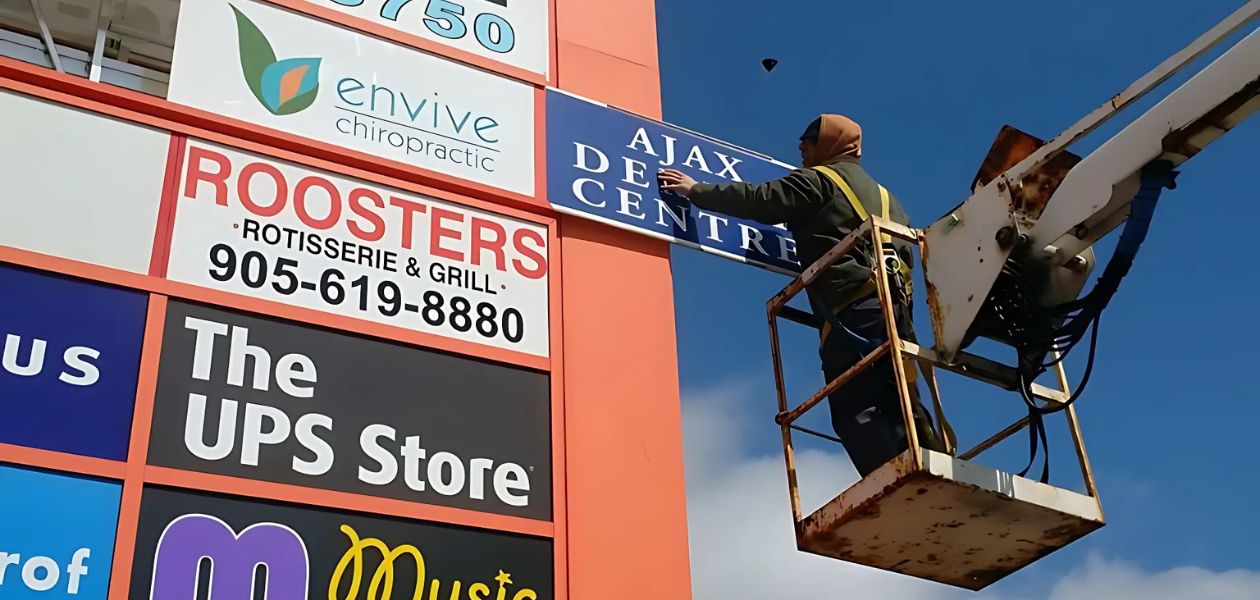What Are the Key Considerations for Outdoor Signs?
Outdoor signs serve as your business’s visual ambassador, attracting customers from a distance and conveying key information about your product.

Whether it's a storefront sign, a directional sign, or a promotional banner, outdoor signs must withstand the elements, remain visible in various conditions, and adhere to local regulations.
In this blog post, we’ll discuss the key considerations when designing and installing outdoor signs, including weather resistance, visibility, size regulations, and tips for ensuring your sign is both durable and effective.
1. Weather Resistance: Ensuring Durability in All Conditions
Outdoor signs are exposed to the elements year-round, so it's crucial to choose materials and finishes that can withstand various weather conditions. From sun and wind to rain and snow, your sign needs to endure while maintaining its appearance and legibility.
- Material Selection: Choose weather-resistant materials such as aluminum, acrylic, PVC, or treated wood for durability. Aluminum is a popular choice for outdoor signs because it’s lightweight, rust-resistant, and can withstand harsh conditions. Acrylic and PVC are also durable and can handle moisture without warping or discoloration.
- UV Protection: UV rays from the sun can cause fading over time, especially for colors and printed graphics. To combat this, choose materials with UV protection or apply a protective coating to your sign. UV-resistant inks for digital prints can also help maintain the vibrancy of your graphics.
- Coatings and Finishes: Protective coatings such as powder coating for metal signs or laminated finishes for printed graphics can extend the life of your outdoor sign by shielding it from environmental damage like corrosion, fading, and scratching.
- Water Resistance: If your sign will be exposed to rain or moisture, consider materials that won’t absorb water or corrode over time. For example, rust-resistant aluminum or waterproof acrylic will help your sign remain intact and legible, even in rainy conditions.
Tip: Regularly inspect your outdoor sign to check for damage due to weather conditions and consider implementing routine maintenance to keep it looking its best.
2. Visibility: Ensuring Your Sign Stands Out
The ultimate goal of an outdoor sign is to attract attention and communicate your message effectively. Visibility is key, and several factors influence how well your sign can be seen by passersby.
- Contrast and Color: Use high-contrast color combinations to make your sign stand out. For example, dark text on a light background or vice versa ensures that the sign is easily readable from a distance. Bright colors like red, yellow, or green are attention-grabbing, but be mindful of your brand colors and choose a combination that aligns with your company's identity.
- Font Size and Style: The text on your sign should be legible from a distance. Choose a font size that’s easy to read without straining, and avoid overly decorative fonts that can make the text hard to decipher. Sans-serif fonts like Arial, Helvetica, or Futura are clean, clear, and typically more visible from a distance.
- Lighting: If your sign will be visible at night or in low-light conditions, consider adding lighting to increase its visibility. Options like backlit signs, spotlights, or LED illumination can help your sign stand out after dark and maintain legibility.
- Positioning: Place your sign in a location where it is easily visible to passersby. Avoid obstructions like trees, signs, or other structures that could block the view. For roadside signs, ensure the sign is placed at an angle that allows drivers or pedestrians to see it clearly as they approach.
Tip: Conduct a test by standing from different distances and angles to see if your sign is legible and noticeable. This can help ensure it performs well in a variety of conditions.
3. Size Regulations: Adhering to Local Zoning Codes
Before finalizing your outdoor sign design, it’s essential to check local zoning and sign ordinances. Many cities or municipalities have regulations regarding the size, placement, and type of signage you can use. Violating these rules can result in fines or the need to remove your sign.
- Size Limits: Depending on your location, there may be restrictions on how large or small your outdoor sign can be. These regulations often vary based on the type of business, the zone in which you are located, and whether your sign is freestanding or mounted to a building.
- Height Restrictions: For freestanding signs, there may be height limits to ensure safety and avoid obstructing the view of drivers or pedestrians. These regulations may also dictate how far your sign must be set back from the street or property lines.
- Design Specifications: In some areas, there are rules about the design elements of a sign, such as the use of certain colors, lighting, or digital displays. Check with your local zoning office to ensure your sign meets all applicable codes.
- Permits: Many municipalities require you to obtain a permit before installing an outdoor sign. Be sure to apply for and receive the necessary permits before moving forward with fabrication and installation.
Tip: Work with a professional sign manufacturer who is familiar with local regulations and can help you design a sign that complies with zoning codes while still meeting your needs.
4. Effective Messaging: Making Sure Your Sign Communicates Clearly
Your outdoor sign isn’t just about catching attention—it’s also about conveying the right message to your audience. To ensure that your sign is effective, keep these tips in mind:
- Clear and Concise: Limit the amount of text on your sign to the most essential information. The average person will only glance at your sign for a few seconds, so ensure that your message is easy to digest. Include your business name, a tagline or call to action, and any relevant contact details (phone number, website, etc.).
- Brand Representation: Your outdoor sign should be a reflection of your brand. Use colors, fonts, and imagery that align with your business identity. A consistent look across all your signage will help reinforce brand recognition and create a cohesive customer experience.
- Call to Action: If you want customers to take a specific action, such as visiting your website or calling your business, include a clear call to action on your sign. For example: "Visit us today!" or "Call for a free consultation!"
- Location-Specific Information: If your business is in a busy area or near landmarks, consider including additional location-specific information on your sign, such as directions or nearby landmarks. This can make it easier for customers to find you.
Tip: Always prioritize legibility and simplicity—avoid cramming too much information into a small space, as this can confuse or overwhelm viewers.
5. Maintenance: Keeping Your Sign Looking Its Best
Once your outdoor sign is installed, it’s important to keep it well-maintained. Regular maintenance will ensure that it continues to look professional and function effectively.
- Cleaning: Outdoor signs are exposed to dirt, dust, and debris, which can accumulate over time. Regularly clean your sign using appropriate materials for the type of sign you have. For example, a metal sign may only need a soft cloth and mild detergent, while a wooden sign might require more specialized care to prevent damage.
- Repairs: Over time, your sign may suffer wear and tear from weather, vandalism, or accidents. Inspect your sign periodically for damage like fading, rust, or cracks. Prompt repairs can prevent further damage and ensure your sign stays in good condition.
- Repainting and Rebranding: If your business undergoes a rebranding or your sign’s colors begin to fade, consider repainting or updating your sign to reflect your new branding and maintain its appeal.
Tip: Schedule regular inspections to catch minor issues before they become major problems.
Conclusion
When designing and installing an outdoor sign, it’s important to consider factors like weather resistance, visibility, size regulations, and effective messaging. By choosing durable materials, ensuring your sign is legible and visible, and complying with local regulations, you can create a sign that not only attracts attention but also stands the test of time.
With these considerations in mind, your outdoor sign will serve as a powerful marketing tool that helps drive awareness, attracts customers, and enhances your brand’s visibility in the competitive marketplace.



